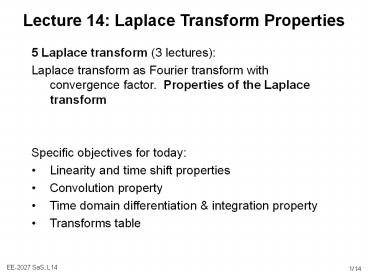Lecture 14: Laplace Transform Properties - PowerPoint PPT Presentation
1 / 14
Title:
Lecture 14: Laplace Transform Properties
Description:
Laplace transform as Fourier transform with convergence factor. ... Laplace transform properties are very similar to the properties of a Fourier ... – PowerPoint PPT presentation
Number of Views:534
Avg rating:3.0/5.0
Title: Lecture 14: Laplace Transform Properties
1
Lecture 14 Laplace Transform Properties
- 5 Laplace transform (3 lectures)
- Laplace transform as Fourier transform with
convergence factor. Properties of the Laplace
transform - Specific objectives for today
- Linearity and time shift properties
- Convolution property
- Time domain differentiation integration
property - Transforms table
2
Lecture 14 Resources
- Core material
- SaS, OW, Chapter 9.59.6
- Recommended material
- MIT, Lecture 18
- Laplace transform properties are very similar to
the properties of a Fourier transform, when sjw
3
Reminder Laplace Transforms
- Equivalent to the Fourier transform when sjw
- Associated region of convergence for which the
integral is finite - Used to understand the frequency characteristics
of a signal (system) - Used to solve ODEs because of their convenient
calculus and convolution properties (today)
Laplace transform
Inverse Laplace transform
4
Linearity of the Laplace Transform
- If
- and
- Then
- This follows directly from the definition of the
Laplace transform (as the integral operator is
linear). It is easily extended to a linear
combination of an arbitrary number of signals
ROCR1
ROCR2
ROC R1?R2
5
Time Shifting Laplace Transforms
- If
- Then
- Proof
- Now replacing t by t-t0
- Recognising this as
- A signal which is shifted in time may have both
the magnitude and the phase of the Laplace
transform altered.
ROCR
ROCR
6
Example Linear and Time Shift
- Consider the signal (linear sum of two time
shifted sinusoids) - where x1(t) sin(w0t)u(t).
- Using the sin() Laplace transform example
- Then using the linearity and time shift Laplace
transform properties
7
Convolution
- The Laplace transform also has the multiplication
property, i.e. - Proof is identical to the Fourier transform
convolution - Note that pole-zero cancellation may occur
between H(s) and X(s) which extends the ROC
ROCR1
ROCR2
ROC?R1?R2
8
Example 1 1st Order Input First Order System
Impulse Response
- Consider the Laplace transform of the output of a
first order system when the input is an
exponential (decay?) - Taking Laplace transforms
- Laplace transform of the output is
Solved with Fourier transforms when a,bgt0
9
Example 1 Continued
- Splitting into partial fractions
- and using the inverse Laplace transform
- Note that this is the same as was obtained
earlier, expect it is valid for all a b, i.e.
we can use the Laplace transforms to solve ODEs
of LTI systems, using the systems impulse
response
10
Example 2 Sinusoidal Input
- Consider the 1st order (possible unstable) system
response with input x(t) - Taking Laplace transforms
- The Laplace transform of the output of the system
is therefore - and the inverse Laplace transform is
11
Differentiation in the Time Domain
- Consider the Laplace transform derivative in the
time domain - sX(s) has an extra zero at 0, and may cancel out
a corresponding pole of X(s), so ROC may be
larger - Widely used to solve when the system is described
by LTI differential equations
12
Example System Impulse Response
- Consider trying to find the system response
(potentially unstable) for a second order system
with an impulse input x(t)d(t), y(t)h(t) - Taking Laplace transforms of both sides and using
the linearity property - where r1 and r2 are distinct roots, and
calculating the inverse transform - The general solution to a second order system can
be expressed as the sum of two complex (possibly
real) exponentials
13
Lecture 14 Summary
- Like the Fourier transform, the Laplace transform
is linear and represents time shifts (t-T) by
multiplying by e-sT - Convolution
- Convolution in the time domain is equivalent to
multiplying the Laplace transforms - Laplace transform of the systems impulse
response is very important H(s) ?h(t)e-stdt.
Known as the transfer function. - Differentiation
- Very important for solving ordinary differential
equations
ROC?R1?R2
14
Questions
- Theory
- SaS, OW, Q9.29-9.32
- Work through slide 12 for the first order system
- Where the aim is to calculate the Laplace
transform of the impulse response as well as the
actual impulse response - Matlab
- Implement the systems on slides 10 12 in
Simulink and verify their responses by exact
calculation. - Note that roots() is a Matlab function that will
calculate the roots of a polynomial expression































